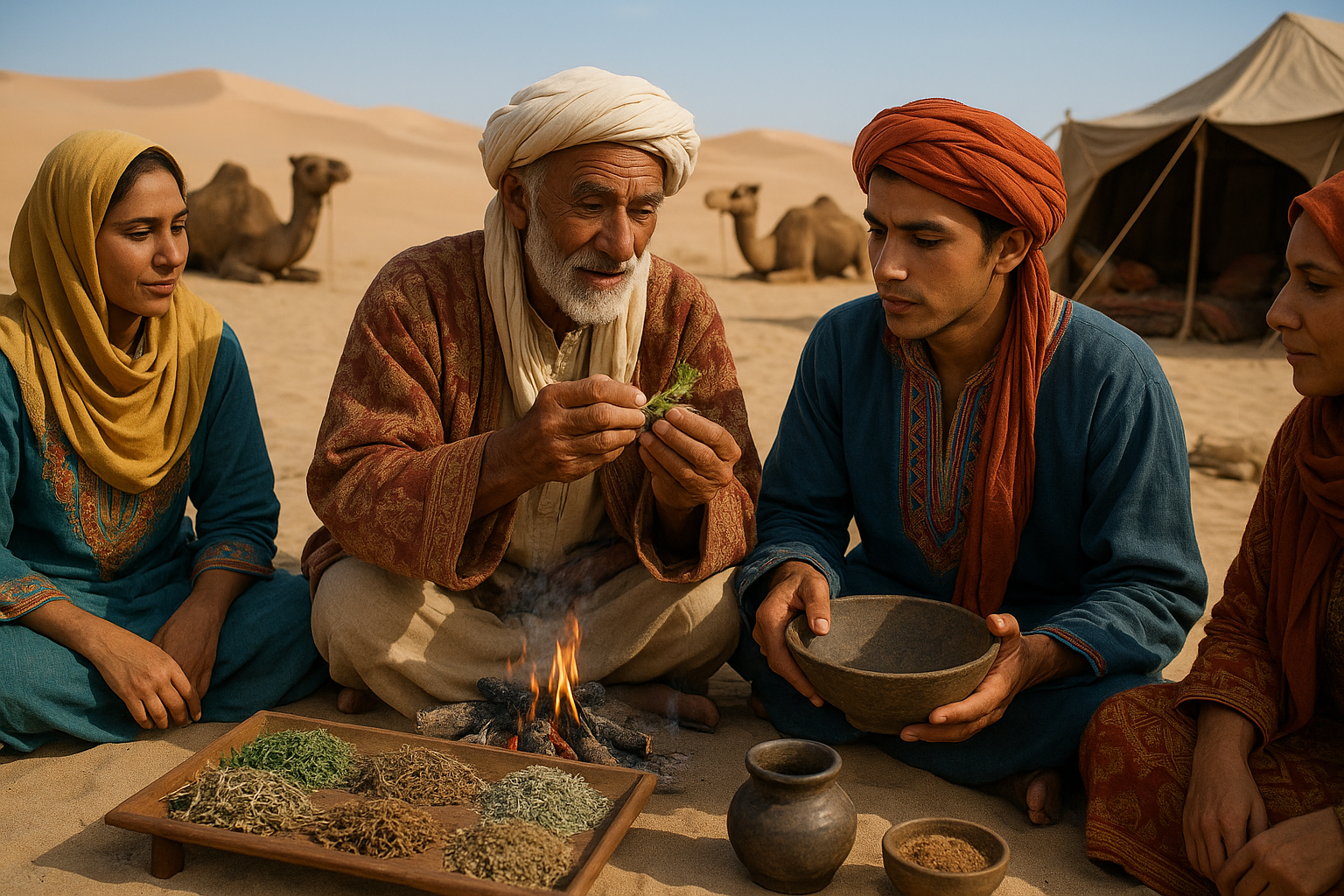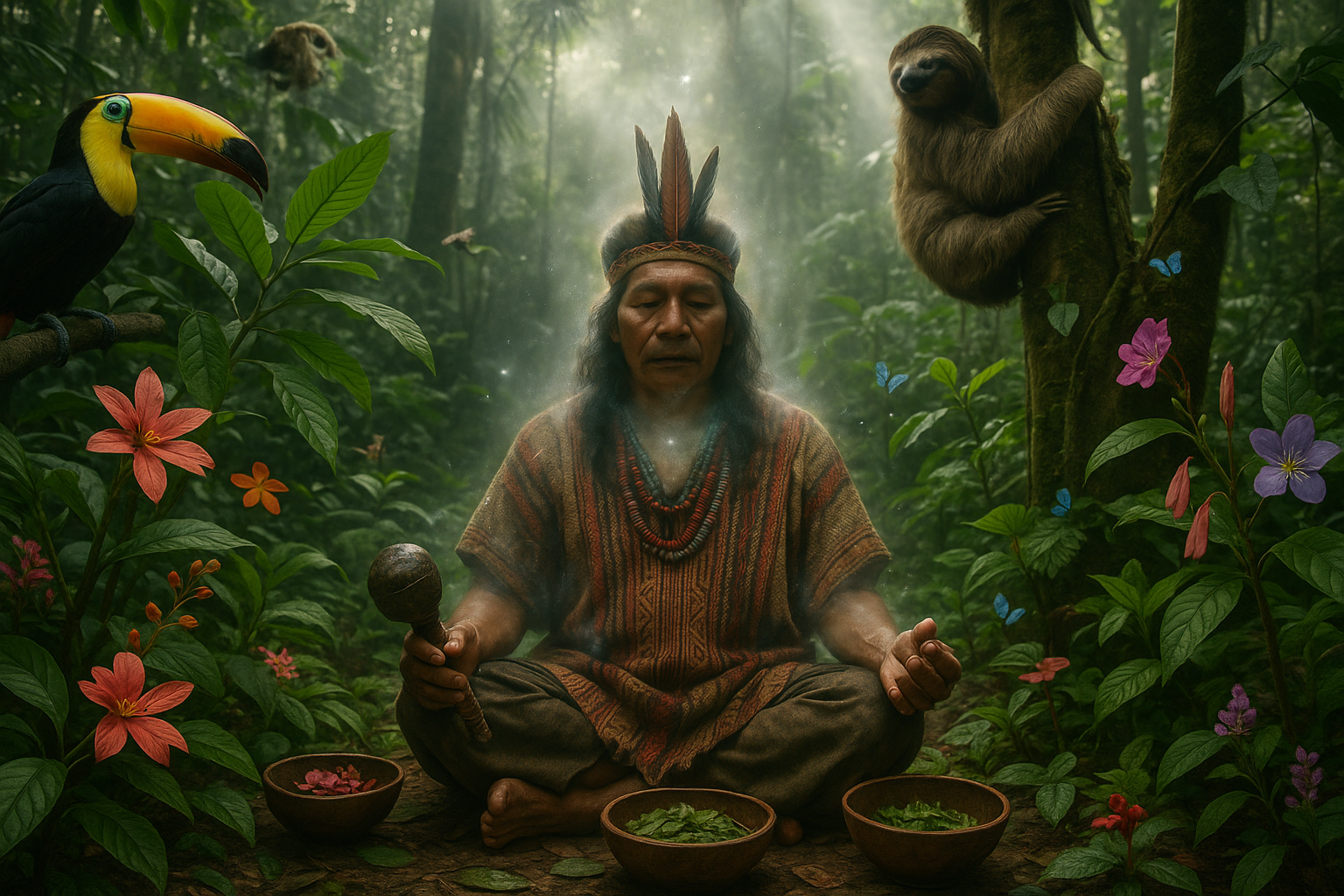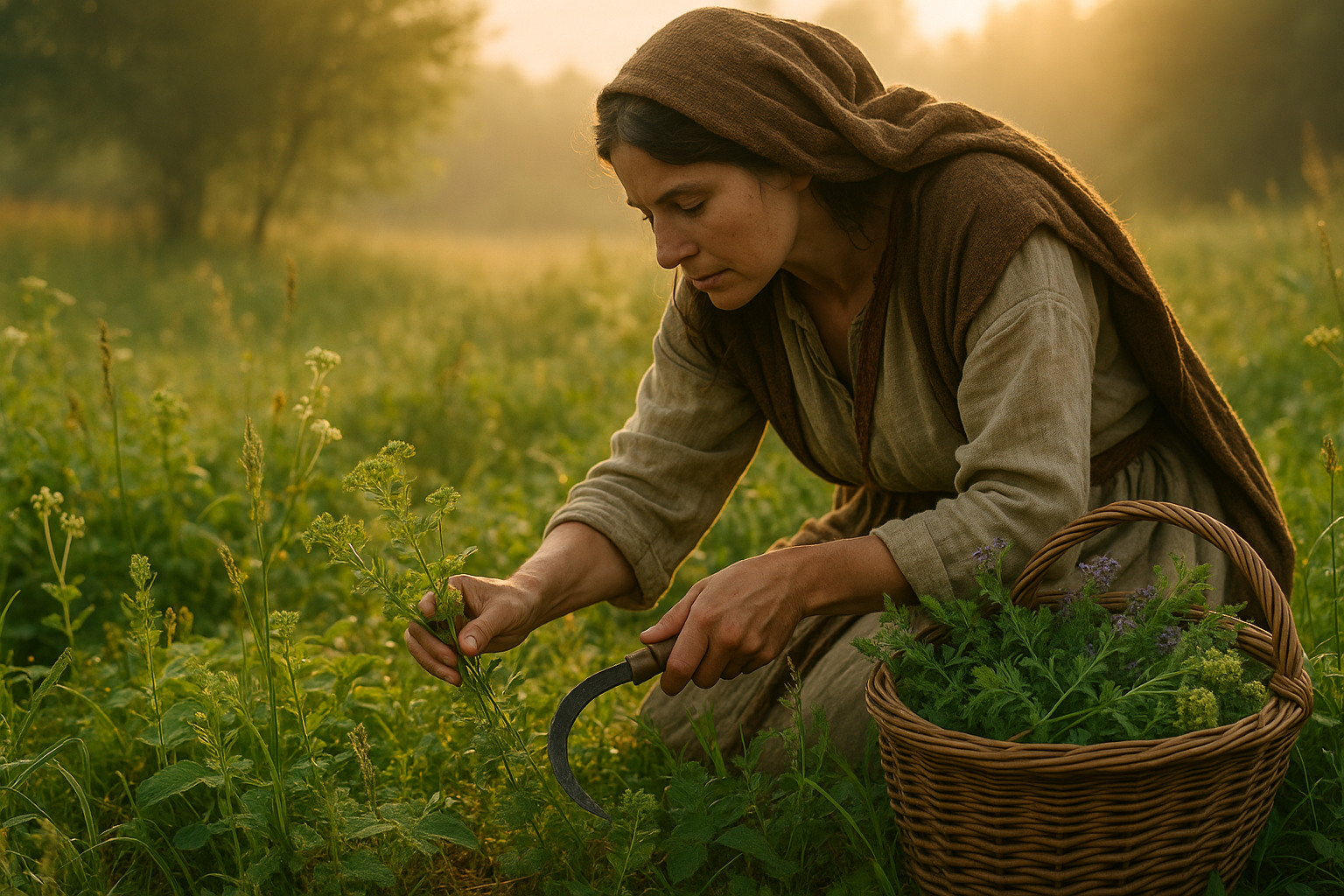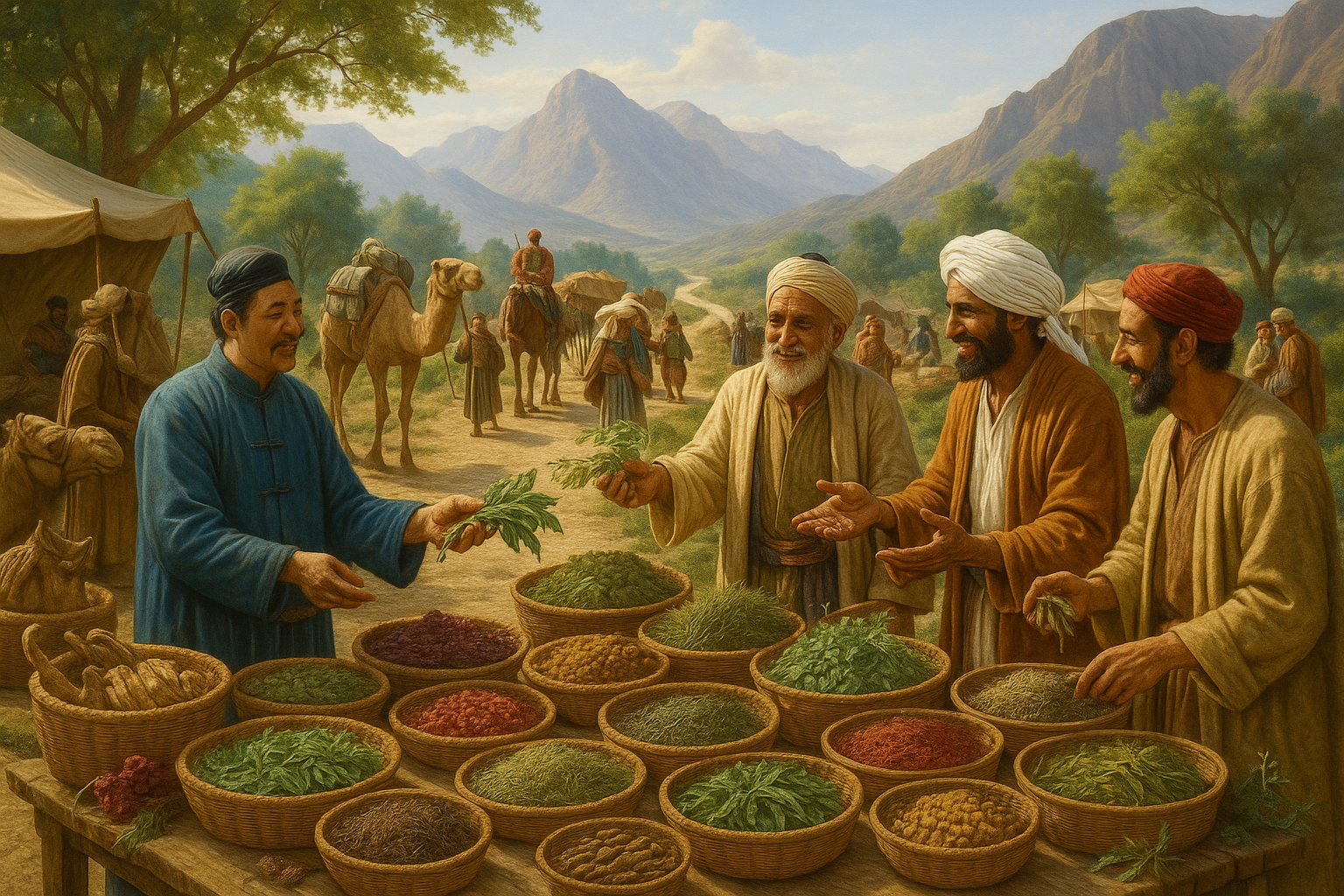In the vast, seemingly desolate stretches of the world’s deserts, where the sun blazes relentlessly and water is a precious commodity, life thrives against all odds. Among the sand dunes and rocky terrains, a remarkable array of herbs flourishes, nurtured by the harshest conditions on Earth. These resilient plants, often overlooked by the untrained eye, hold secrets of health and wellness that have been treasured by nomadic cultures for centuries. 🌿✨
Imagine walking through the arid landscape, the sun casting long shadows as it dips below the horizon, painting the sky with hues of orange and purple. As the cool night air descends, the desert comes alive with the scent of wild herbs, their essential oils released by the evening breeze. These plants, deeply intertwined with the lives of desert nomads, offer more than just a lifeline in an unforgiving environment; they are the cornerstone of traditional medicine, nutrition, and spiritual practices.
In this exploration of desert herbs, we delve into how these ancient cultures have harnessed nature’s bounty, transforming what many would consider barren land into a thriving apothecary. From the arid expanses of the Sahara to the vast stretches of the Arabian Desert, nomadic tribes have perfected the art of using indigenous plants not only to survive but to thrive. 🌍
Throughout this article, we will uncover the fascinating stories behind these herbs and their uses, providing insight into how they contribute to health and wellness. You’ll discover the likes of the fragrant Frankincense, renowned for its meditative properties and its role in traditional rituals. We’ll also delve into the healing powers of the Aloe Vera, a plant revered for its soothing and restorative abilities, often referred to as the “desert lily.”
The nutritional aspects are equally compelling. Many desert herbs serve as vital food sources, packed with nutrients that support the nomadic lifestyle. Take, for example, the nutrient-dense seeds of the Argan tree, which not only provide sustenance but also yield oil cherished for its health benefits and culinary uses. 🌰🥄
But it’s not just about physical health. The spiritual and cultural significance of these herbs is profound. They are woven into the fabric of nomadic life, used in ceremonies and storytelling, helping to foster a deep connection with the land. This spiritual dimension adds another layer of richness to our understanding of these plants.
In the pages that follow, we will explore the sustainable practices these communities employ to harvest these herbs, ensuring that their precious resources remain abundant for future generations. This aspect of desert herb utilization is particularly relevant in today’s context of environmental conservation and the growing interest in sustainable living.
By the end of this journey, you’ll have a newfound appreciation for the power of desert herbs and the wisdom of the nomadic cultures that rely on them. You’ll see how these ancient practices can inspire modern approaches to health and wellness, encouraging us to look towards nature for holistic solutions. 🌱💪
Join us as we unearth the secrets of these desert jewels, discovering how their ancient uses can be adapted to contemporary life. Whether you’re seeking natural remedies, curious about traditional practices, or simply fascinated by the resilience of life in extreme environments, this exploration offers something for everyone. Let’s dive into the world of desert herbs and unveil the timeless knowledge of those who call the desert home.
# Unearthing the Power of Desert Herbs: How Nomadic Cultures Harness Nature’s Bounty for Health and Wellness
## Discovering the Secrets of Nomadic Wisdom 🌿
The vast, arid deserts of the world might seem barren and devoid of life at first glance. Yet, they hold within them a treasure trove of herbs and plants that have been utilized for centuries by nomadic cultures for their remarkable health and wellness benefits. The resilience and resourcefulness of these cultures have allowed them to harness the power of desert herbs to survive and thrive in some of the harshest conditions on Earth.
Nomadic tribes, with their unique understanding of the natural world, have identified and used various desert plants for medicinal purposes. This ancient knowledge, passed down through generations, reveals a profound connection between humans and their environment. From the Bedouins of the Middle Eastern deserts to the Tuareg of the Sahara, these groups have developed sophisticated herbal practices that are not only effective but also sustainable.
The intriguing relationship between these communities and their surroundings underscores the importance of preserving indigenous knowledge. In today’s world, where modern medicine often overlooks traditional remedies, understanding and integrating these ancient practices can open new avenues for health and wellness. Let’s delve deeper into how these desert herbs are identified, harvested, and used, shedding light on the wisdom of nomadic cultures.
## A Glimpse into the Desert’s Botanical Treasure Trove 🌵
### Recognizing Medicinal Plants: A Nomad’s Expertise
For nomadic tribes, the desert is not a mere backdrop but a living entity that provides for their needs. Identifying medicinal plants is a skill that requires keen observation and a deep understanding of the ecosystem. These communities have developed unique ways to recognize useful herbs, often through subtle signs such as the plant’s shape, color, or habitat.
For example, the Bedouins have long relied on the Resurrection Plant (Anastatica hierochuntica), known for its ability to survive extreme dehydration. This plant is believed to aid in childbirth and alleviate menstrual cramps. Similarly, the Argan Tree (Argania spinosa), native to the Moroccan desert, produces oil rich in antioxidants and essential fatty acids, widely used in skincare and culinary applications.
The knowledge of these plants is often shared through oral traditions, with elders teaching the younger generations. This transfer of knowledge is crucial, as it ensures the survival of both the culture and the practical uses of these herbs. In an age where biodiversity is under threat, such knowledge is invaluable for conservation efforts and the discovery of new medicinal compounds.
### Harvesting Techniques: Balancing Use and Sustainability
Nomadic tribes employ sustainable harvesting techniques to ensure that desert herbs remain a renewable resource. They understand the importance of maintaining ecological balance, often gathering plants in a manner that allows for regrowth. This practice is not only environmentally friendly but also ensures that future generations can benefit from these natural resources.
For instance, the Tuareg people, who inhabit the Sahara, use a methodical approach when harvesting the Acacia Tree. They collect the gum without harming the tree, ensuring it continues to produce for years to come. The gum, known for its soothing properties, is used to treat digestive issues and skin ailments.
Such practices highlight the profound respect these cultures have for nature. By adhering to sustainable methods, they not only preserve the environment but also protect their cultural heritage and way of life. These practices serve as a model for modern approaches to resource management and conservation.
### A Table of Herbal Remedies and Uses
The following table provides an overview of some desert herbs commonly used by nomadic cultures, along with their traditional applications. This comparison underscores the diversity and richness of desert flora, inviting readers to explore these natural remedies further.
| Herb | Traditional Use | Region |
| Anastatica hierochuntica | Childbirth aid, menstrual cramp relief | Middle East |
| Argania spinosa | Skincare, culinary oil | Morocco |
| Acacia gum | Digestive health, skin treatments | Sahara |
## Ancient Practices with Modern Relevance
### Integrating Traditional Knowledge with Modern Science
The intersection of traditional herbal knowledge and modern science presents an exciting frontier in medicine. By studying the practices of nomadic cultures, researchers can uncover new insights into the properties and potential applications of desert herbs. This fusion of ancient wisdom and contemporary research holds the promise of innovative treatments and therapies.
For example, the Resurrection Plant has garnered interest in the scientific community for its remarkable resilience. Studies have shown that the plant’s ability to survive desiccation could lead to breakthroughs in drought-resistant crops and new preservation techniques. Similarly, the antioxidant properties of Argan Oil have been validated by research, confirming its efficacy in skincare and health.
Collaboration between indigenous communities and scientists can enhance our understanding of these plants, leading to sustainable development and utilization. This partnership is crucial in ensuring that the benefits of traditional knowledge are recognized and respected, paving the way for ethical research and innovation.
### The Role of Desert Herbs in Modern Health and Wellness
Desert herbs offer a natural alternative to synthetic drugs, with many people turning to these remedies for their holistic benefits. The growing interest in herbal medicine reflects a desire for more sustainable and organic healthcare solutions. By integrating these herbs into modern wellness practices, individuals can benefit from their therapeutic properties while supporting biodiversity and cultural preservation.
From herbal teas to topical treatments, the applications of desert herbs are vast and varied. The Acacia Tree, for example, is used to produce a natural gum that serves as a prebiotic, promoting gut health. Its anti-inflammatory properties make it a popular ingredient in skincare products. By incorporating these herbs into daily routines, people can enhance their health while embracing the wisdom of ancient cultures.
### Watch and Learn: A Visual Exploration
For a visual exploration of the fascinating world of desert herbs and their uses, watch the insightful video below. It provides an engaging overview of how nomadic cultures utilize these plants, offering a deeper understanding of their significance and applications.
Exploring Desert Herbs – Channel Name
## Embracing the Nomadic Approach to Wellness
### Lifestyle Lessons from Nomadic Cultures
Beyond the use of herbs, nomadic cultures offer valuable lessons in lifestyle and wellness. Their connection to the land, minimalist living, and focus on community well-being are aspects that can inspire modern approaches to health. By embracing these principles, individuals can cultivate a more balanced and fulfilling life.
Nomadic tribes prioritize physical activity, often walking long distances as part of their daily routine. This active lifestyle contributes to their overall well-being, demonstrating the importance of movement and exercise. Additionally, their emphasis on communal living fosters strong social bonds and mental health, highlighting the role of community in wellness.
The nomadic diet, rich in whole foods and free from processed ingredients, further exemplifies their commitment to natural living. By adopting similar dietary habits, individuals can improve their health and vitality. These lifestyle practices, rooted in centuries of tradition, offer practical insights for those seeking a holistic approach to wellness.
### Creating a Sustainable Future with Herbal Medicine
As the demand for natural remedies grows, it is essential to ensure that the use of desert herbs is both sustainable and respectful of indigenous knowledge. By supporting ethical sourcing and fair trade practices, consumers can contribute to the preservation of these valuable resources and the cultures that rely on them.
Educational initiatives that raise awareness about the importance of desert herbs and their traditional uses can further promote conservation efforts. By recognizing the contributions of nomadic cultures, society can foster a more inclusive and sustainable approach to health and wellness. This commitment to sustainability not only benefits the environment but also honors the legacy of those who have stewarded these resources for generations.
### Exploring Further: Engage with the Topic
To continue exploring the fascinating world of desert herbs and their applications, consider delving into additional resources and engaging with communities that share this interest. Whether through workshops, online forums, or further reading, there are numerous opportunities to deepen your understanding and appreciation of this rich cultural heritage.
- Join a local herbal medicine group to learn and share knowledge.
- Participate in workshops or courses on traditional herbal practices.
- Explore literature and documentaries on nomadic cultures and desert herbs.
These steps not only enhance personal learning but also contribute to the broader movement of preserving and promoting traditional herbal medicine. By engaging with this topic, individuals can become advocates for sustainable health practices that honor both nature and cultural diversity.

Conclusion
In exploring the fascinating world of desert herbs and their integral role in nomadic cultures, we have journeyed through a rich tapestry of history, tradition, and modern application. These resilient plants, thriving in some of the harshest climates on Earth, offer an impressive array of health benefits that have been cherished and utilized by nomadic peoples for centuries.
From the vast expanses of the Sahara to the arid landscapes of the Arabian Peninsula, nomadic tribes have mastered the art of harnessing nature’s bounty. They have relied on these natural resources not only for survival but also for enhancing their well-being. The knowledge and practices passed down through generations have demonstrated how deeply intertwined their cultural identity is with the environment they inhabit.
Key to this relationship is the understanding and use of herbs like Desert Lavender, Sagebrush, and Frankincense. These plants serve not only as medicinal aids but also as spiritual and nutritional staples. The antimicrobial properties of Sagebrush, for instance, are used to treat infections, while the aromatic Frankincense plays a role in rituals and as a remedy for inflammation.
The significance of these plants extends beyond traditional uses. As modern science delves deeper into the study of these herbs, we uncover more about their potential benefits, confirming and even expanding upon traditional knowledge. This fusion of ancient wisdom and modern research highlights the importance of preserving these cultural practices and recognizing their value in today’s world.
Understanding the sustainable practices of nomadic cultures also provides valuable lessons in environmental stewardship. By living in harmony with their surroundings and using resources judiciously, these communities exemplify a sustainable model that modern societies can learn from, especially as we face global environmental challenges.
As we reflect on the power of desert herbs and the wisdom of nomadic cultures, it becomes clear that there is much to gain from integrating these age-old practices into contemporary health and wellness paradigms. Embracing this knowledge not only enriches our own lives but also ensures the preservation of these traditions for future generations.
🌿 We invite you to share your thoughts and experiences with desert herbs and their uses in the comments below. Have you tried any of these remedies yourself? What impact did they have on your health and well-being? Your insights could inspire others to explore and appreciate the remarkable legacy of nomadic herbal wisdom. 🌍
Furthermore, consider sharing this article with friends or on social media to spread awareness about the incredible benefits of desert herbs. Together, we can foster a deeper appreciation for these natural wonders and the cultures that have nurtured them for centuries.
Let’s continue the conversation and explore more about how we can incorporate these ancient practices into our daily lives, ensuring a healthier, more balanced future for all. 🌟
For further reading, explore resources that delve into the ethnobotany of desert regions and the sustainable practices of nomadic cultures. Let us carry forward the wisdom of the past to enlighten our present and future.
This conclusion provides a recap of the article, reinforces the significance of the topic, and encourages reader engagement. Remember to adapt and personalize the content to align with your article’s specific details and findings.
Toni Santos is a researcher and practitioner specializing in the study of ancestral healing systems, energetic frameworks of the body, ancient herbal traditions, and sacred operative procedures. Through an interdisciplinary and historically-rooted lens, Toni investigates how humanity has preserved and transmitted knowledge of preventive health, subtle anatomy, plant medicine, and ritual intervention — across cultures, lineages, and sacred traditions. His work is grounded in a fascination with healing not only as physical remedy, but as carriers of hidden wisdom. From ancestral preventive health practices to energetic healing maps and ritual operative techniques, Toni uncovers the visual and symbolic tools through which cultures preserved their relationship with the body, spirit, and plant world. With a background in ethnomedical history and comparative anatomy systems, Toni blends archival research with practical study to reveal how ancient societies used plants, energy, and ceremony to shape health, transmit wisdom, and encode sacred knowledge. As the creative mind behind jirenx.com, Toni curates illustrated frameworks, historical case studies, and symbolic interpretations that revive the deep cultural ties between ancestral medicine, energetic healing, and sacred procedure. His work is a tribute to: The lost healing wisdom of Ancestral Preventive Health Practices The guarded rituals of Energetic Anatomy and Healing Maps The ancient knowledge of Herbal Pharmacology of Antiquity The layered sacred practice of Ritual Surgery and Sacred Operations Whether you're a traditional medicine scholar, energetic healer, or curious seeker of ancestral health wisdom, Toni invites you to explore the hidden roots of sacred medicine — one practice, one map, one ritual at a time.




